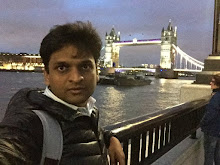
A lot had been written about this movie for past fifty years. There are no new words left behind to praise the movie. This movie gave a Ray of light to Indian cinema, through which the whole world can take a look at the real condition of people in Indian villages and this man named Satyajit Ray became the sole representative of Indian cinema in international arena. You all know, which movie I am talking, the most popular Indian movie of all time, “Pather Panchali”.
It is as simple and as realistic as a movie can get. It is about the struggles of a poor family to survive with a hopeless man as head of the family, who dreams to become a writer but ends up getting some temporary jobs. Even after nearly 50 years of its release, the movie looked very contemporary in all aspects. I never got the feeling that I am watching an old movie, may be because the interior villages in India are in the same conditions even now as it was then. I heard that Ray used to sketch all the scenes in the movie before shooting and while shooting he will follow the sketches and visualize accordingly and may be that was the reason for those stunning visuals with brilliant and beautiful cinematography even by the technical standards of today. The black and white picture has got a classy tone of it’s own and enhances the impact of this (subtly) emotional drama.
The controlled and down to earth performance of each and every actor (are they?) is another factor for the impact that the movie leaves. The other technical aspects like sound design, art direction is great considering the period it was made. Like say, when Hari and his wife is speaking inside the house, we get to hear the voice of their aunt singing from outside. Hope those days, movies were not shot with synch-sound. I mean the sound design is carefully done. The movie is first in the Apu trilogy but this movie hardly focuses on Apu but the climax definitely ends with a hope on Apu to uplift his family. The first part focuses basically on Durga and her little desires and emotions.
The ending is really haunting. The way that panic situation is picturised is brilliant with the doors dashing to open due to heavy wind blowing outside, the idol of Vinayak shaking on a stand inside the house and Durga lying in the bed shivering in fever and cold with her mother hugging by her side, the most touching scene in the movie and we could anticipate what is going to happen but again the movie stands out by the way Ray handles this tragic situation with utmost subtlety in the very next scene.
I liked the background score by Pandit Ravishankar of the movie a lot. Those days, I don’t think most moviemakers or even the composers concentrated on this department much. The haunting flute and sitar pieces sprinkled all through the movie enhance the visuals and are pleasant to listen to it along with the poetic visuals. Actually I am searching for this music CD, can anyone tell me where can I find it. What else to say, this movie is a masterpiece for sure (sorry I can’t close without using this).
11.17.2005
Pather Panchali - A RAY of Light to Indian Cinema
Posted by P.S. Suresh Kumar at 11:56 PM
Subscribe to:
Post Comments (Atom)



4 comments:
Ahoy....you seem to be in a classic watching spree...great dude. Keep writing about such great pieces.
muthuvel,
yes of course i am.
I also very recently watched this movie and was spell bound by it. Have you watched all three in the Apu's trilogy?
no prasad, i have to watch other two movies. it is not available in the rental shop in which i am renting DVD's anyway they have said they will get it soon.
Post a Comment